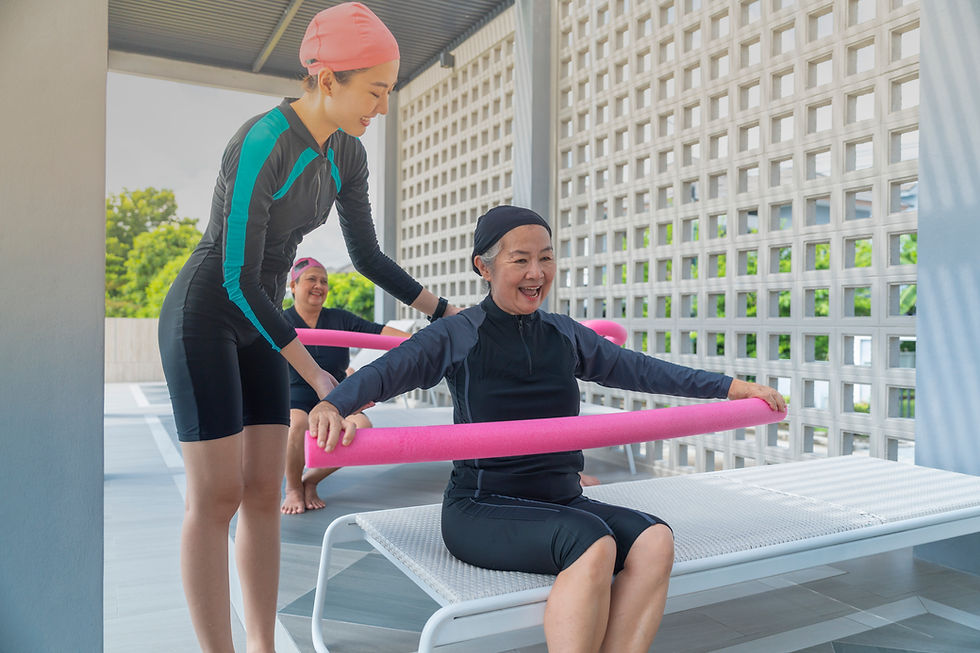Want a Stronger Back? Try These Physiotherapy Core Exercises
- Jun 26
- 3 min read
Updated: Jul 4

Simple, Effective Exercises to Support a Healthy Spine and Better Posture
A strong core is essential for spinal health, posture, and injury prevention. Weak core muscles can lead to back pain, poor balance, and an increased risk of injury. By incorporating physiotherapy-based core exercises into your routine, you can strengthen your abdominal, back, and pelvic muscles, helping to support your spine and relieve mild discomfort.
Here are some simple yet effective physiotherapy exercises you can do at home to build a stronger back and healthier posture.
1. Upper Back Stretch
Targets: Upper back, shoulders, and neck
Benefits: Improves flexibility, reduces shoulder tension, and enhances postural alignment
How to Do It:
Extend your arms in front of you and clasp your hands together. Gently pull your shoulder blades apart. Lower your head forward and hold for 10 seconds.
Why It Helps:
This stretch relieves stiffness in the upper spine, which is especially helpful for individuals who sit for long hours or experience neck and shoulder tightness.
2. Shoulder Blade Squeeze
Targets: Upper back, shoulders
Benefits: Strengthens postural muscles and promotes better spinal alignment
How to Do It:
Clasp your fingers behind your back. Squeeze your shoulder blades together. Slowly straighten your arms and lift them slightly. Hold for 10 seconds, then release.
Why It Helps:
By engaging the muscles responsible for posture, this exercise prevents slouching and helps maintain an upright spine.
3. Neck Stretch
Targets: Neck, upper back
Benefits: Reduces neck tension and improves flexibility
How to Do It:
Place your right hand on the right side of your head. Reach behind your back with your left hand. Gently tilt your head towards your right shoulder until you feel a light stretch. Hold for 10 seconds, then switch sides.
Why It Helps:
This stretch relieves stiffness in the neck and upper spine, making it ideal for desk workers or individuals with chronic neck pain.
4. Glute Bridge
Targets: Core, lower back, glutes
Benefits: Strengthens core stability and supports lower back health
How to Do It:
Lie on your back with knees bent and feet flat on the floor. Tighten your core muscles and lift your hips off the floor. Hold the position for 5 seconds, then lower back down. Repeat 10 times.
Why It Helps:
Glute bridges engage the core and lower back muscles, helping to aim to improve postural awareness and core engagement
5. Opposite Arm and Leg Raise
Targets: Core, lower back, shoulders
Benefits: Improves balance, coordination, and spinal support
How to Do It:
Lie on your back with arms and legs extended. Raise your right leg and left arm at the same time. Hold for 2-3 seconds, then switch sides. Repeat 10 times per side.
Why It Helps:
This movement enhances core control, improving overall spinal stability and coordination.
6. Knee-to-Chest Stretch
Targets: Lower back, hips
Benefits: Improves flexibility and mobility in the lower back
How to Do It:
Lie on your back and cross your right foot over your left knee. Gently pull your left knee toward your chest. Hold for 10 seconds, then switch sides.
Why It Helps:
This stretch relieves tension in the lower back and hip muscles, promoting better movement and reducing discomfort.
How Often Should You Do These Exercises?
For best results, aim to perform these exercises 3 to 5 times a week. Consistency is key to building strength, reducing back pain, and improving posture.
Beginners: Start with one set of 10 repetitions for each exercise.
Intermediate: Progress to two sets as your strength improves.
Advanced: Maintain good form and gradually increase intensity as needed.
Take the Next Step Towards a Stronger, Healthier Back
If you experience chronic back pain or poor posture, physiotherapy-based exercises can help improve core strength, stability, and flexibility.
At AquaPhysio Rehab Centre, we offer:
Personalised programmes aimed at supporting spinal strength
Exercises to promote core strength and mobility
Guidance on maintaining postural health through movement
Aquatic therapy sessions for gentle, low-impact exercise
Book a consultation to explore personalised physiotherapy options.



